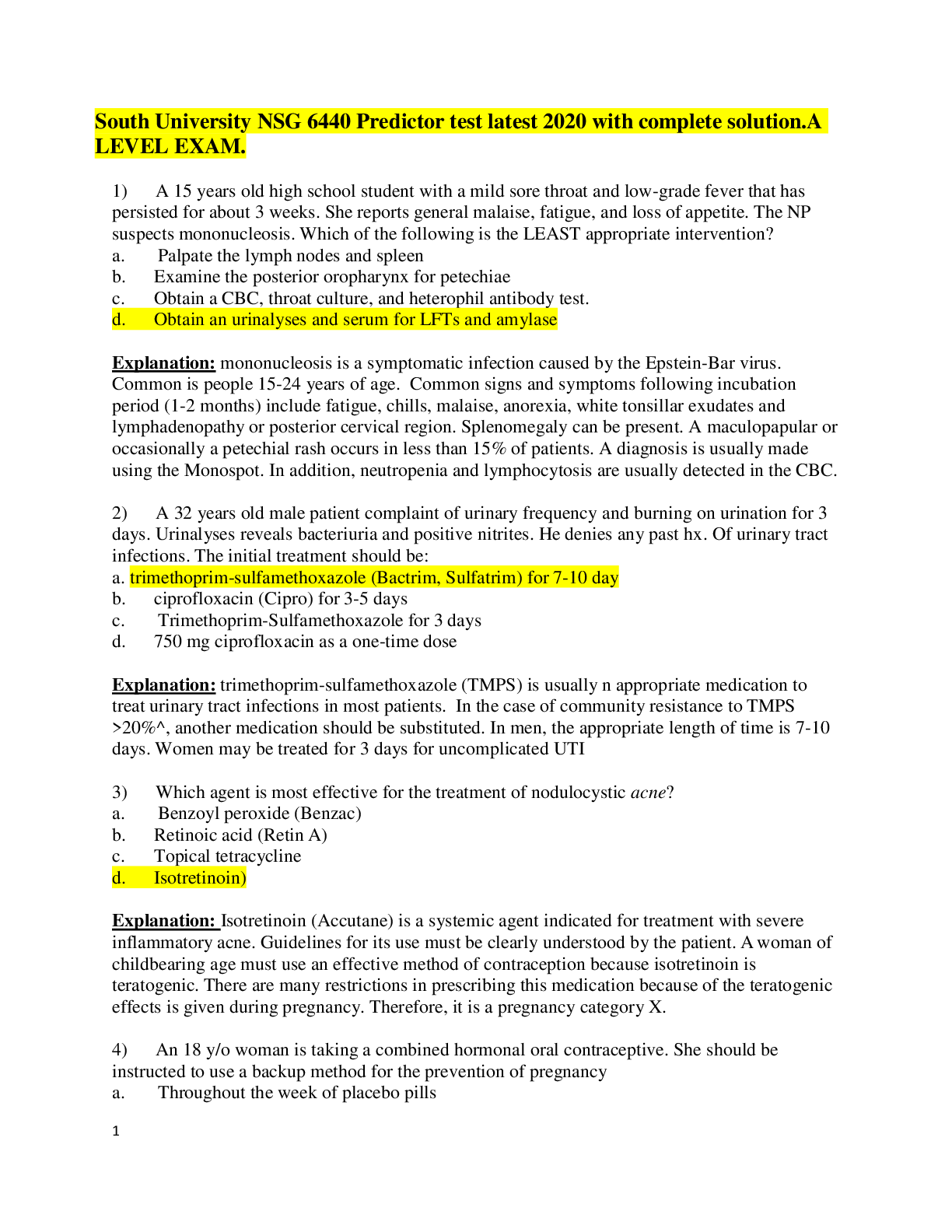BioChemistry > QUESTIONS & ANSWERS > WGU BioChem C785 Carbohydrates and ATP Exam Questions with COMPLETE SOLUTION (All)
WGU BioChem C785 Carbohydrates and ATP Exam Questions with COMPLETE SOLUTION
Document Content and Description Below
WGU BioChem C785 Carbohydrates and ATP Exam Questions with COMPLETE SOLUTION During gluconeogenesis, how many ATP molecules are consumed for each glucose molecule produced? 4 2 1 6 - ✔✔6 Whic... h molecule signals the liver to release glucose by breaking down glycogen? ATP Eicosanoids Glucagon Insulin - ✔✔glucagon High levels of glucose stimulate insulin which increases glycogen formation. Which molecule is regenerated with the production of lactate during anaerobic metabolism? FAD NAD+ FADH2NADH - ✔✔NAD+ During aerobic metabolism, acetyl-CoA is produced from which molecule? Glycerol Oxaloacetate Pyruvate Lactate - ✔✔Pyruvate Acetyl-COA is produced from the breakdown of pyruvate after glycolysis. Why would a marathon runner consume a large meal full of complex carbohydrates the night before her run? To replenish cellular stores of DNA To replenish cellular stores of protein To replenish cellular stores of ketone bodies To replenish cellular stores of glycogen - ✔✔To replenish cellular stores of glycogen Why must red blood cells rely solely on glycolysis to make ATP? Red blood cells lack mitochondria.Red blood cells lack cytoplasm. Red blood cells absorb too much oxygen. Red blood cells cannot absorb oxygen. - ✔✔Red blood cells lack mitochondria. Red blood cells transport oxygen by hemoglobin but lack mitochondria. What are advanced glycation end products (AGEs)? Glucose molecules linked to DNA or RNA without the need for enzymes The end products of glycolysis The end products of glycogenolysis Glucose molecules linked to lipids or proteins without the need for enzymes - ✔✔Glucose molecules linked to lipids or proteins without the need for enzymes AGEs are glucose molecules linked to lipids and proteins. Why are blood glucose levels high in patients with unmanaged Diabetes Mellitus? Cells move too many GLUT4 transporters to their cell membranes. Ketogenesis is stimulated in the liver. Cells do not move enough GLUT4 transporters to their cell membranes.Ketogenesis is suppressed in the liver. - ✔✔Cells do not move enough GLUT4 transporters to their cell membranes. Cells that do not move enough GLUT4 transporters to the cell membranes will cause blood glucose levels to be high. What kind of molecule is glycogen? A complex carbohydrate A triglyceride A protein A simple carbohydrate - ✔✔A complex carbohydrate What happens in the liver cells when they respond to insulin? GLUT4 transporters move to the surface of the cell. Gluconeogenesis is increased. Beta-oxidation of fatty acids is increased. Glycogenolysis is increased. - ✔✔GLUT4 transporters move to the surface of the cell Glycogenolysis will decrease as a result of insulin release. Glycogenolysis breaks down glycogen into glucose. Insulin is released in response to high blood sugar and additional glucose is not needed.What is the function of fermentation during anaerobic metabolism? Fermentation regenerates the NAD+ needed for glycolysis. Fermentation regenerates the NADH needed for glycolysis. Fermentation consumes the NAD+ produced by glycolysis. Fermentation consumes the lactic acid produced by glycolysis. - ✔✔Fermentation regenerates the NAD+ needed for glycolysis. Fermentation produces NAD+. NAD+ is needed as a substrate for glycolysis. How does the proton gradient affect the pH of the mitochondrial matrix and the intermembrane space? The concentration of protons in the intermembrane space is higher than the concentration in the matrix. The pH of the intermembrane space is higher than the pH of the matrix. The pH of the intermembrane space is higher than the pH of the cytoplasm. The concentration of protons in the matrix is higher than the concentration in the intermembrane space. - ✔✔The concentration of protons in the intermembrane space is higher than the concentration in the matrix. The intermembrane space of mitochondria has a high concentration of hydrogen ions (H+) which makes the pH very low compared to the cytoplasm.If a patient is healthy and has a normal oxygen concentration in her blood, approximately how many ATP are produced for every molecule of glucose that enters the process of metabolism? 4 30 6 2 - ✔✔30 Since the patient has normal oxygen levels, their cells will undergo aerobic respiration. 30 ATP is generated per 1 glucose molecule as a result of aerobic respiration. 4 ATP is the amount of ATP used in one complete cycle of the Cori Cycle. Since 2 ATP are made during glycolysis and 6 are used in gluconeogenesis, this would mean that there is a net loss of 4 ATP. The Cori Cycle utilizes gluconeogenesis to convert the products of fermentation back into glucose, which occurs during anaerobic respiration. Oxygen levels are normal, so most likely aerobic respiration is being utilized by the cells. A defect in an enzyme in the citric acid cycle causes the cycle to stop functioning. What is a possible consequence? Decreased levels of ATP Increased levels of NADH Decreased levels of acetyl-CoA Increased levels of ATP - ✔✔Decreased levels of ATP Since the citric acid cycle is no longer working, then there will be no production of NADH and FADH2, therefore levels of NADH would decrease. These molecules are required in order to generate ATP. Without these molecules transporting electrons to the electron transport chain, ATP levels will decrease. Acetyl-CoA is used in the citric acid cycle. If the citric acid cycle is stopped, the acetyl-CoA levels would increase.Which of the following best describes the role of ATP synthase? ATP synthase allows protons to flow down their concentration gradient into the matrix and generates ATP. ATP synthase allows protons to flow against their concentration gradient into the intermembrane space and generates ATP. ATP synthase allows protons to flow down their concentration gradient into the intermembrane space and generates ATP. ATP synthase allows protons to flow against their concentration gradient into the matrix and generates ATP. - ✔✔ATP synthase allows protons to flow down their concentration gradient into the matrix and generates ATP. Protons flow down their concentration gradient through ATP synthase, from the intermembrane space into the matrix. Which of the following occur during aerobic respiration? NAD+ and FAD donate electrons to the ETC, regenerating NADH and FADH2. Water donates electrons to the ETC, producing oxygen. NADH and FADH2 are produced from NAD+ and FAD during the citric acid cycle. NAD+ and FAD are produced from NADH and FADH2 during the citric acid cycle. - ✔✔NADH and FADH2 are produced from NAD+ and FAD during the citric acid cycle. The citric acid cycle uses the NAD+ and FAD to produce NADH and FADH2. Glycolysis is the conversion of glucose to pyruvate. Is this a catabolic process or an anabolic process?Catabolic None of the these Anabolic Anabolic and Catabolic Incorrect. The correct answer is 'Catabolic'. Anabolic reactions created bonds and build molecules. In glycolysis, glucose is being broken down. This process is catabolic. - ✔✔Catabolic Anabolic reactions created bonds and build molecules. In glycolysis, glucose is being broken down. This process is catabolic. Which of the following is an accurate statement about glycolysis? The final products of glycolysis are two molecules of pyruvate. All of these Glycolysis results in a net production of four ATP molecules. Glycolysis is the breakdown of a glucose molecule that requires the presence of oxygen. - ✔✔The final products of glycolysis are two molecules of pyruvate. Cyanide binds to complex IV of the electron transport chain, preventing electron transport. Which of the following would be the most immediate effect of cyanide consumption? ADP will build-up. ATP synthase will produce ATP. Oxygen would be consumed by the ETC.Protons will not be pumped to the mitochondrial matrix. - ✔✔ADP will build-up Since the electron transport chain can no longer function because the electrons are blocked at complex IV, the protons cannot be pumped into the intermembrane space. As a result, ATP synthesis will drastically decrease. Glucose that is phosphorylated after entering the cell cannot move through GluT transporters. True False - ✔✔True Glucose that is phosphorylated after entering the cell cannot move through GluT transporters. During the reactions of the Electron Transport Chain, hydrogens are pumped by complexes _________ and move from the matrix to the _________. I, III, & IV; intermembrane space II & IV; cytoplasm I, II, & III; intermembrane space I, III, & IV; cytoplasm - ✔✔'I, III, & IV; intermembrane space During the reactions of the Electron Transport Chain, hydrogens are pumped by complexes I, III, & IV and move from the matrix to the intermembrane space. Complexes I, III, and IV do pump electrons the membrane into the intermembrane space, not the cytoplasm. Complex II does not directly pump electrons into the intermembrane space, instead, it pumps electrons to Coenzyme Q10 which passes them to complex III, which then pumps them across the membrane. What is the fate of pyruvate when oxygen is absent?Pyruvate is converted to lactate and enters the Cori cycle. Pyruvate remains unchanged causing tissue levels to increase leading to cell damage. Pyruvate undergoes gluconeogenesis to form glucose. Pyruvate is converted to acetyl-CoA and enters cellular respiration. - ✔✔Pyruvate is converted to lactate and enters the Cori cycle. There is no energy gained (and in fact energy is required) when converting pyruvate to lactate. Why is this a necessary step? NAD+ is required for gluconeogenesis to occur. Fermentation is the only pathway that creates ATP. NAD+ is required for glycolysis to occur. Lactate is required for gluconeogenesis to occur. - ✔✔NAD+ is required for glycolysis to occur Gluconeogenesis is the process that occurs after fermentation in the Cori Cycle. Lactate fermentation regenerates NAD+ from NADH. NAD+ is essential for glycolysis to occur, which is the step where the 2 ATP of anaerobic metabolism are made. Glycolysis produces two ATP molecules through which process? [Show More]
Last updated: 1 year ago
Preview 1 out of 25 pages
Instant download
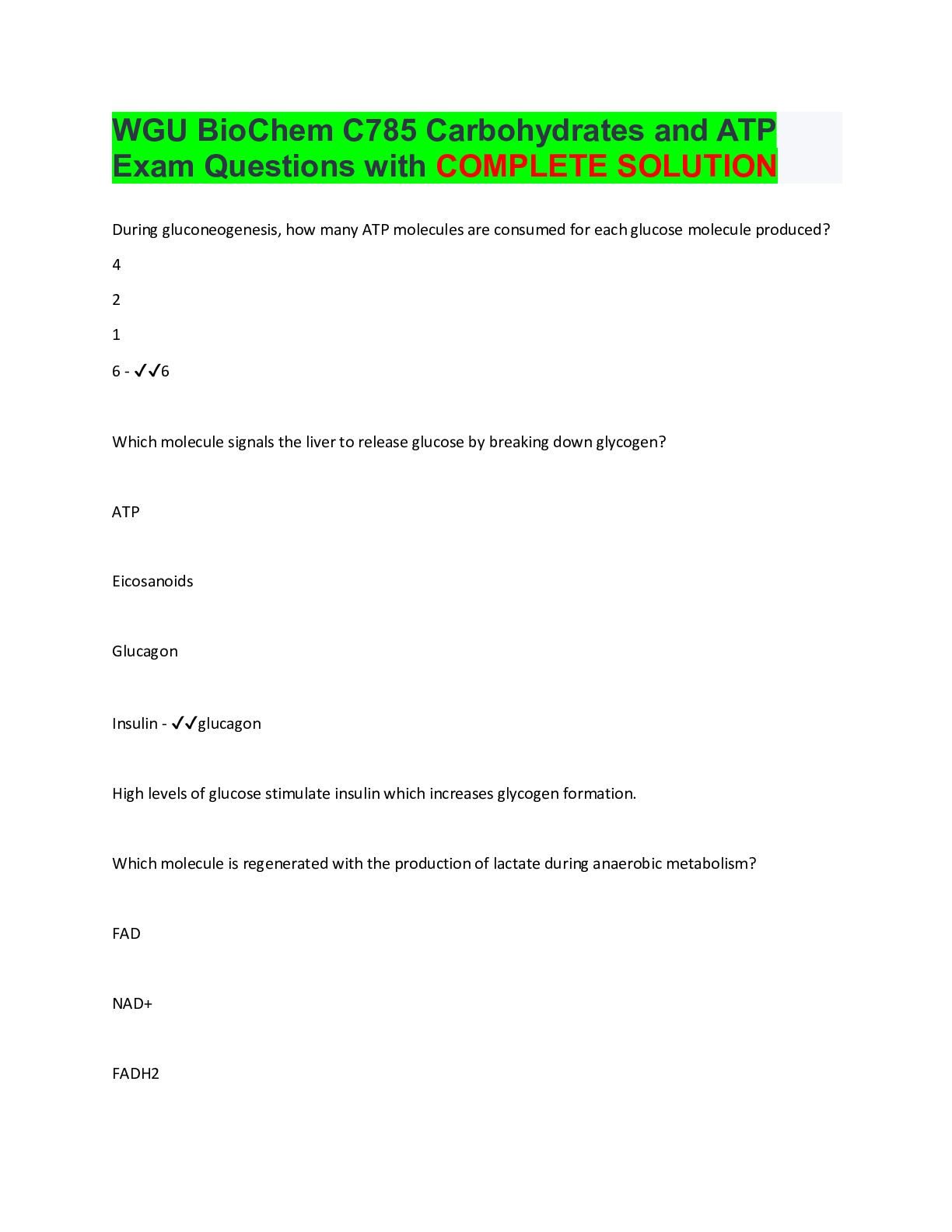
Buy this document to get the full access instantly
Instant Download Access after purchase
Add to cartInstant download
Reviews( 0 )
Document information
Connected school, study & course
About the document
Uploaded On
Sep 14, 2022
Number of pages
25
Written in
Additional information
This document has been written for:
Uploaded
Sep 14, 2022
Downloads
0
Views
63














.png)
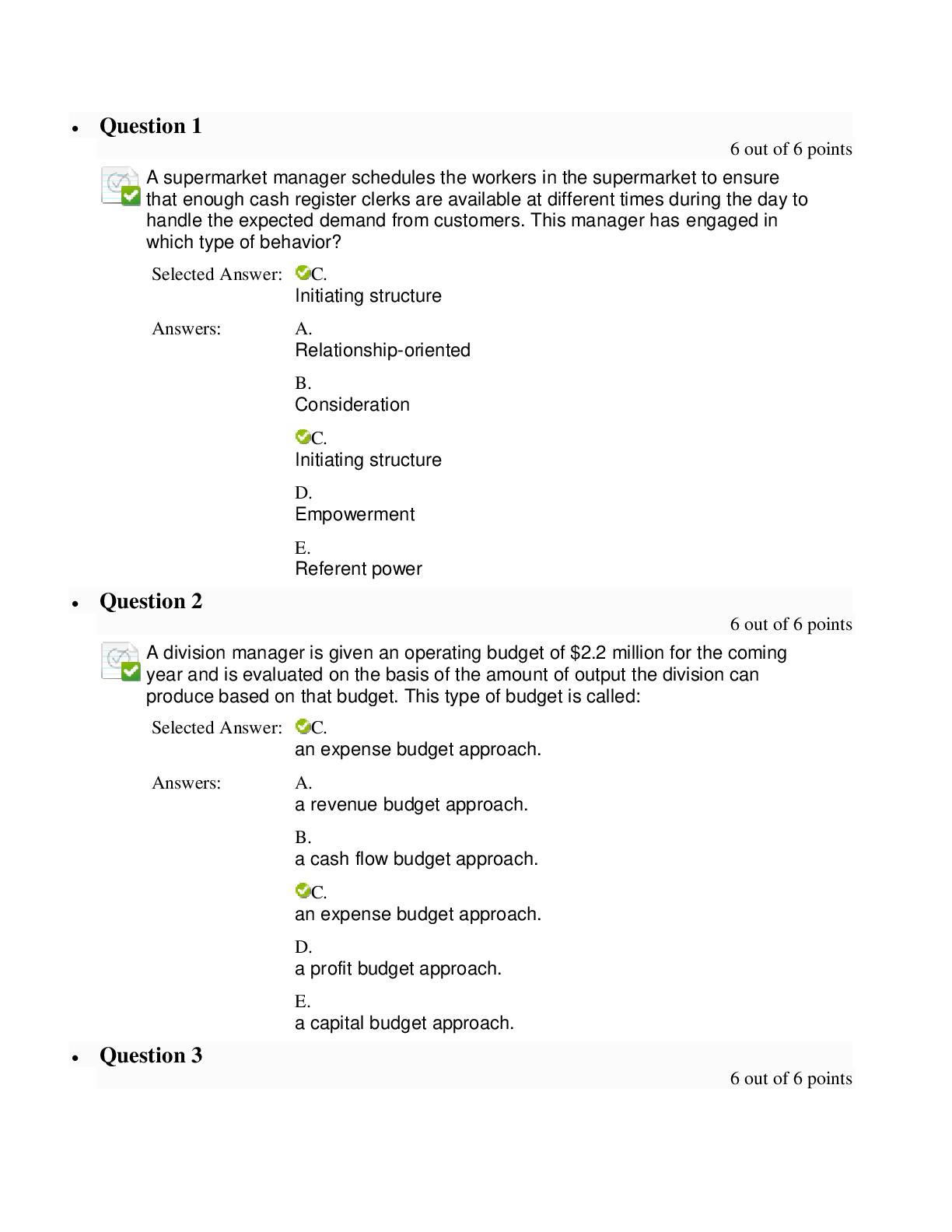

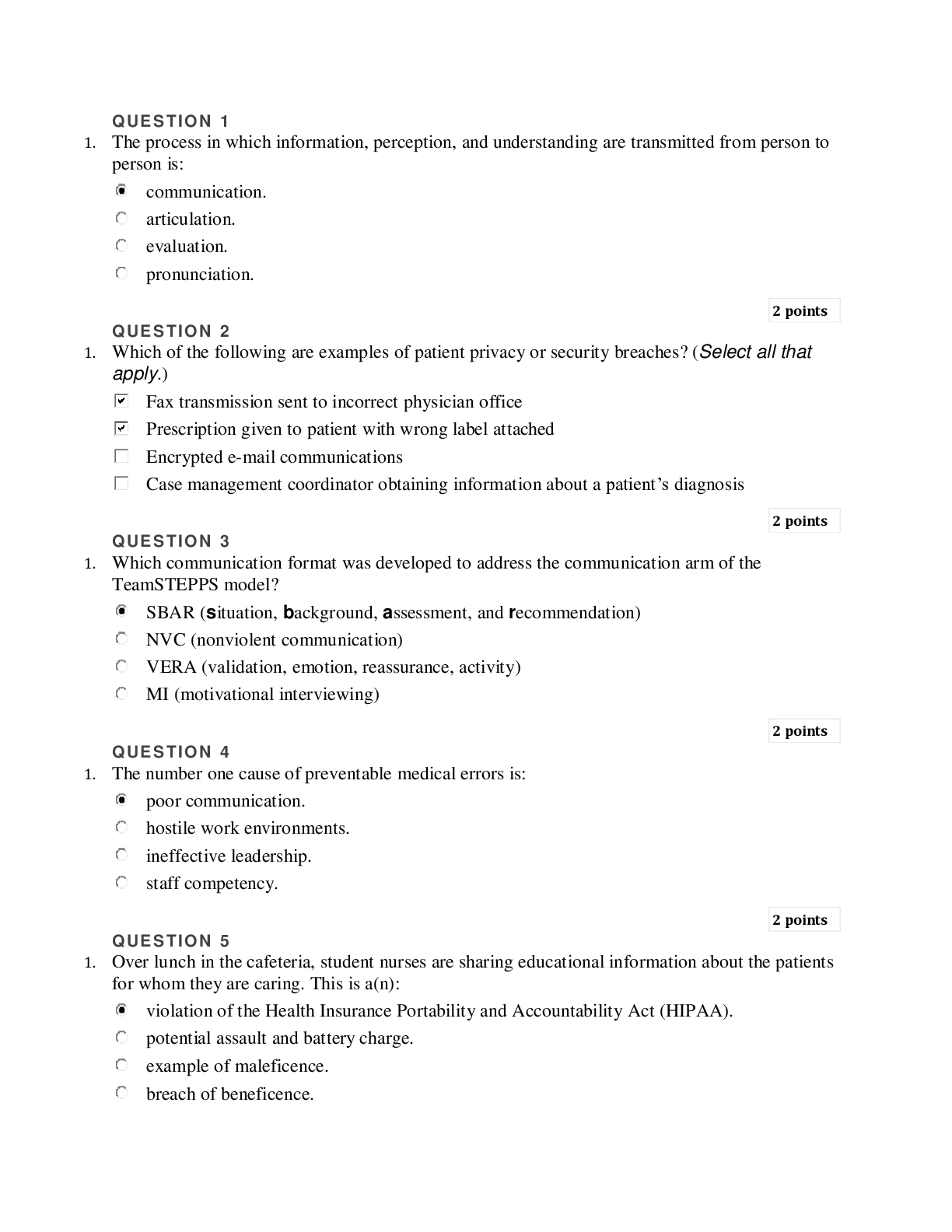
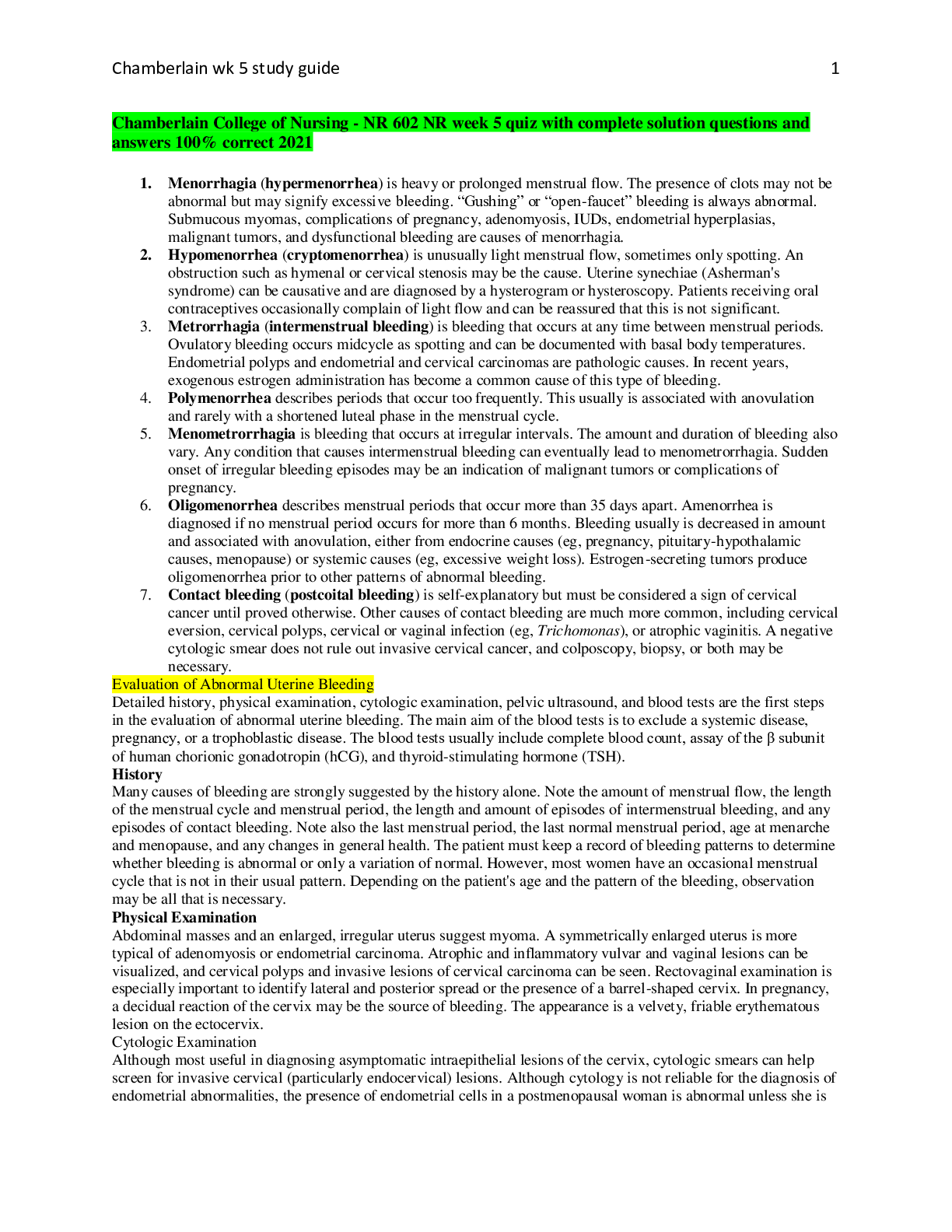

.png)

